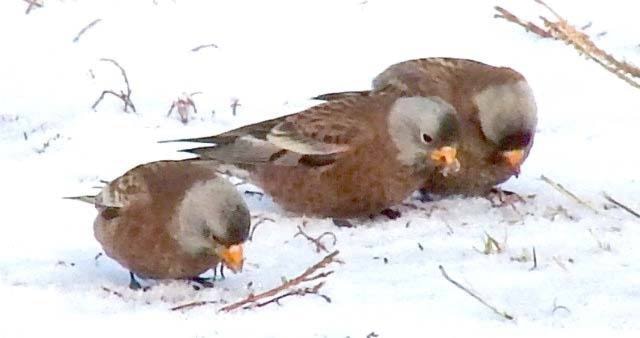Daryl Calder
A good number of naturalists from the East Kootenay and Crowsnest Pass joined forces on December 27 for the Cranbrook Christmas Bird Count.
With the help of several feeder watchers, a wide variety of birds were counted on the cool, cloudy, calm day. Sometimes, a large number of individuals of a particular species such as Bohemian Waxwings, will skew the total, but that was not the case this year.
Similarly, the species count can be elevated when only one individual of each of several species is observed. This occurred with the Rough-legged Hawk, Eurasian Collared-Dove, Black-billed Magpie, Chestnut-backed Chickadee and Golden-crowned Kinglet, although these birds are not particularly uncommon.
Unfortunately, such year round birds as the Great Blue Heron, Northern Goshawk, Red-tailed Hawk, Golden Eagle, Blue and Ruffed Grouse, Northern Pygmy Owl, Belted Kingfisher and Brown Creeper could not be found. Naturalists were pleased with their effort and opportunity to contribute to the 116th Audubon CBC.
One little, non-migrating bird which is common in mature, mixed woods is the White-breasted Nuthatch. All three species of North American nuthatches are found in the East Kootenay. The White-breasted is the largest; it's clean markings give it a rather appealing look. It is successful because of it's attributes and habits.
The name nuthatch is actually a corruption of the word nuthack, because of it's tendency to wedge seeds into crevices and hack them open with it's bill. Thanks to strong legs and toes, long, curved talons and a long, strong bill, this active, agile bird can walk up, down and sideways on tree trunks and large limbs. Starting near the top of a tree and spiralling it's way down, this nuthatch forages intensively.
 Pictured: White-breasted nuthatch
Pictured: White-breasted nuthatch
Unlike woodpeckers which rely on their stiff tails to keep them anchored, the White-breasted uses the long, claw-like hind toe on each foot to get a grip.
During the summer, when probing bark crevices, they prefer to eat spiders and insects including ants, caterpillars, weevils and beetles. In winter, they switch to a more vegetarian diet with more seeds. They continue to eat many insects which are pried from their wintering spots in bark crevices. In developed areas, they have learned to eat suet and peanut butter mixes as well.
The white-breasted stores large quantities of food in winter, by poking it into bark furrows and tree crevices. By using each storage site only once, food is dispersed across it's territory, a practice known as scatterhoarding. The precious food stores are often covered up with bark flakes or lichen. With a life span of 10 or 12 years, one can only imagine how much detail this bird will learn about it's habitat.
Often heard before it is seen; it's nasal 'quank' is distinctive and strong. The male performs a rather simple song, a regular series of six to eight notes.
Pairs form long term bonds and remain on nesting territories year round. They do not generally excavate their own holes, but nest in a natural cavity or old woodpecker hole. Occasionally, they use artificial nest boxes. The female builds the nest, which is a soft cup of bark fibers, grass, hair and feathers. Sometimes mud is added to the entrance of the cavity, perhaps to keep larger predators away. They will also brush the nest, inside and out, with a crushed insect. The chemical secretions may keep predators away.
The female incubates five to nine eggs for 12-14 days. The male feeds the female while she incubates, and helps her feed the young when they hatch. The little ones leave the nest after 14-26 days, but stay with the adults for several more weeks until they become completely independent.
The Cranbrook List:
Total Species — 49
Total Individuals — 1876
• Canada Goose - 9
• Mallard - 171
• Bufflehead - 2
• Common Goldeneye - 17
• Barrow's Goldeneye - 2
• Hooded Merganser - 7
• Wild Turkey - 41
• Cooper's Hawk - 2
• Bald Eagle - 12
• Rough-legged Hawk - 1
• Rock Pigeon - 116
• Eurasian Collared-Dove - 1
• Downy Woodpecker - 25
• Hairy Woodpecker - 20
• Northern Flicker - 28
Pileated Woodpecker - 6
Merlin - 5
• Northern Shrike - 3
• Grey Jay - 6
• Steller's Jay - 8
• Blue Jay - 18
• Black-billed Magpie - 1
• Clark's Nutcracker - 22
• American Crow - 100
• Common Raven - 163
• Black-capped Chickadee - 169
• Mountain Chickadee - 84
• Chestnut-backed Chickadee - 1
• Red-breasted Nuthatch - 61
• White-breasted Nuthatch - 2
• American Dipper - 10
• Golden-crowned Kinglet - 1
• Townsend's Solitaire - 5
• European Starling - 25
• Bohemian Waxwing - 105
• Dark-eyed Junco - 4
• Song Sparrow - 15
• Grey-crowned Rosy Finch - 35
• Pine Grosbeak - 105
• House Finch - 282
• Cassin's Finch - 10
• Red Crossbill - 15
• White-winged Crossbill - 10
• Common Redpoll - 90
• Hoary Redpoll - 7
• Pine Siskin - 6
• American Goldfinch - 9
• Evening Grosbeak - 12
• House Sparrow - 24
Submitted by Daryl Calder
on behalf of Rocky Mountain Naturalists
